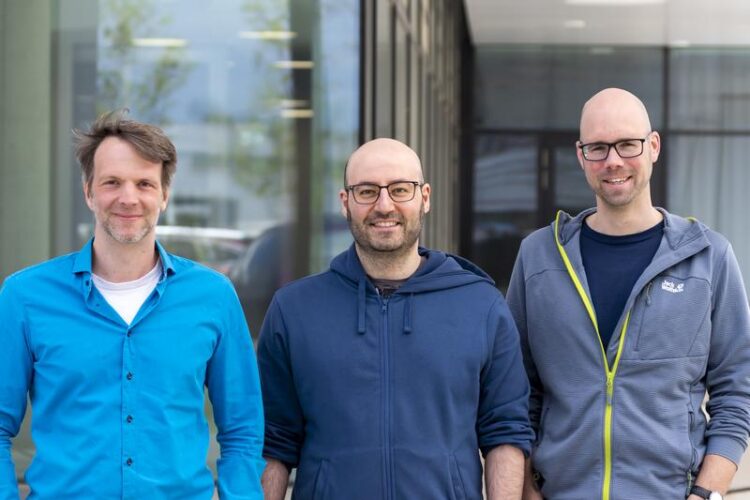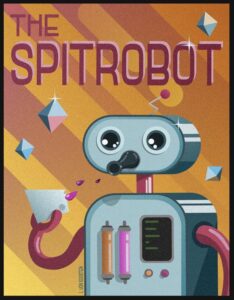Time-resolved crystallography for the masses

Left to right: Friedjof Tellkamp (MPSD), Pedram Mehrabi (UHH) and Eike C. Schulz (UKE)
(c) Jörg Harms, MPSD
Scientists from four research institutes in the Science City Hamburg Bahrenfeld have joined forces to develop a ground-breaking experimental setup. Their new Spitrobot greatly simplifies observing changes in proteins as they carry out their functions. This makes time-resolved crystallography accessible for non-specialist research groups, as samples can now be prepared in standard labs and processed by automated established high-throughput methods elsewhere. The device will accelerate fundamental research in health and disease. The team has now presented the concept behind the Spitrobot in Nature Communications.

(c) Lea von Soosten, UKE
To develop future drugs and design new biotechnological applications, it is fundamental that scientists understand the changes in proteins while these are taking place. Currently, the beginning and the end of the reaction can be addressed but the many intermediate steps are usually missing from the picture. The simplest way to visualize these different steps is to take ‘snapshots’ of the protein throughout the reaction. Many such snapshots put together then produce a 3D ‘stop-motion-movie’, showing the changes in the protein structure over time from all angles.
So far, such experiments have required direct access to particle accelerators (synchrotrons and XFELs) and complex experimental setups, which are out of reach for many scientists. Therefore, researchers from Hamburg University (UHH), the Max Planck Institute for the Structure and Dynamics of Matter (MPSD), the European Molecular Biology Laboratory (EMBL) and the University Medical Center Hamburg Eppendorf (UKE) (all in Hamburg) have devised a different and far more accessible alternative – the Spitrobot.
The Spitrobot dramatically simplifies the entire sample preparation process, from the initial fixing of the protein crystals and kick-starting the reaction through to the precise cryo-trapping of the proteins at various stages of their transformation. Reactions are initiated simply by ‘spitting’ the substrate solution onto the target – a technology previously developed by the team. By vitrification of the samples (i.e. cooling them to a glass-like state) the Spitrobot uncouples sample preparation from data collection. Using industry standards ensures the convenient dispatch of the samples and their compatibility with high-throughput routines commonly available at synchrotrons and other facilities. Thus the experiment can be carried out in standard laboratories without immediate access to light sources – a major advantage to most researchers in structural biology.
Emmy Noether research group leader Pedram Mehrabi (UHH) and first author of the Nature Communications paper says: “The Spitrobot will greatly accelerate research in enzymatic mechanisms. It enables non-specialist groups to carry out experiments that could previously only be done by experts. This should lead to the much more wide-spread application of a really hard experiment.”
The Spitrobot has its technological origins at the MPSD where Mehrabi and last author Eike C. Schulz worked together with the Institute’s Scientific Support Unit led by Friedjof Tellkamp. Schulz and Mehrabi continued their work at the UKE and UHH respectively to benchmark the device and demonstrate its applicability to biotechnological and disease-related problems. They were joined in their efforts by colleagues from the EMBL Hamburg who demonstrated that changes in the protein can be observed during catalytic reactions.
“We devised the Spitrobot with the typical structural biology lab in mind. That is why we aimed for a versatile, robust and simple solution that allows users to work with large and small crystals alike and combines the simplest way of reaction initiation with the ability to cover the time-scales of the majority of enzymes. This will allow many more research groups to address a wider spectrum of questions, ranging from biotechnology to health and disease research,“ says Schulz, who now leads his own junior research group in infection research at the UKE, funded by the German Ministry for Education and Research.
Wissenschaftliche Ansprechpartner:
Pedram Mehrabi, lead author: pedram.mehrabi@mpsd.mpg.de / pedram.mehrabi@uni-hamburg.de
Originalpublikation:
https://www.nature.com/articles/s41467-023-37834-w
Weitere Informationen:
Media Contact
All latest news from the category: Life Sciences and Chemistry
Articles and reports from the Life Sciences and chemistry area deal with applied and basic research into modern biology, chemistry and human medicine.
Valuable information can be found on a range of life sciences fields including bacteriology, biochemistry, bionics, bioinformatics, biophysics, biotechnology, genetics, geobotany, human biology, marine biology, microbiology, molecular biology, cellular biology, zoology, bioinorganic chemistry, microchemistry and environmental chemistry.
Newest articles
Faster, more energy-efficient way to manufacture an industrially important chemical
Zirconium combined with silicon nitride enhances the conversion of propane — present in natural gas — needed to create in-demand plastic, polypropylene. Polypropylene is a common type of plastic found…

Energy planning in Ghana as a role model for the world
Improving the resilience of energy systems in the Global South. What criteria should we use to better plan for resilient energy systems? How do socio-economic, technical and climate change related…

Artificial blood vessels could improve heart bypass outcomes
Artificial blood vessels could improve heart bypass outcomes. 3D-printed blood vessels, which closely mimic the properties of human veins, could transform the treatment of cardiovascular diseases. Strong, flexible, gel-like tubes…




















